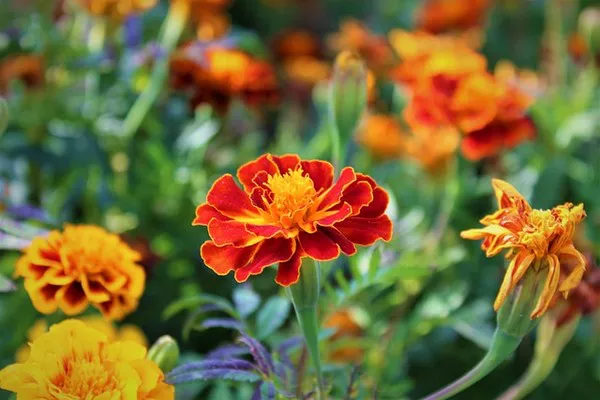Flowers have long held a special place in human culture, symbolizing beauty, growth, and various emotions. Among the myriad of floral marvels, the marigold flower stands out with its unique and captivating appearance. Revered for its vibrant colors and distinctive features, the marigold has been cherished across cultures and generations. In this article, we explore the visual splendor of the marigold flower, delving into its physical characteristics, variations, and cultural significance.
A Blossom of Radiance: Unveiling Marigold’s Physical Characteristics
The marigold, scientifically known as Calendula officinalis, is a member of the Asteraceae family. It is renowned for its captivating beauty, with petals that exude a sense of vibrancy and warmth. Typically, a marigold flower consists of multiple layers of petals arranged in a compact, concentric manner. These petals exhibit a diverse range of colors, from vivid yellows and oranges to deep reds and even maroon hues.
The marigold’s most distinctive feature is its layered composition. The central disk, often darker in color, is surrounded by a series of ray florets that radiate outward. These ray florets can be uniformly colored or exhibit a gradient effect, transitioning from one hue to another. The arrangement of these florets creates a mesmerizing play of colors that draws the gaze of beholders.
The texture of marigold petals is velvety and slightly coarse to the touch, adding to its tactile appeal. When observed up close, the intricate veining on the petals becomes apparent, contributing to the flower’s overall visual complexity. Marigolds typically possess a symmetrical form, with a circular or slightly oval outline.
Exploring Marigold Variations: A Kaleidoscope of Beauty
The marigold flower exhibits a remarkable diversity in terms of color, size, and petal arrangement. This variation has led to the development of numerous cultivars, each with its own unique visual charm.
1. French Marigold (Tagetes patula):
These marigolds are known for their compact size and delicate appearance. They feature small, intricate flowers with a single or double layer of petals. French marigolds come in a plethora of colors, ranging from sunny yellows and fiery oranges to rich reds and bi-color combinations.
2. African Marigold (Tagetes erecta):
As the name suggests, African marigolds are characterized by their larger size and robust stature. They boast vibrant, full blooms with layers of densely packed petals. These marigolds often come in shades of yellow and orange, and their impressive size makes them a favorite choice for adding a bold statement to garden beds.
3. Signet Marigold (Tagetes tenuifolia):
Signet marigolds are distinctive for their lacy foliage and small, dainty flowers. The petals of signet marigolds are typically a softer shade of yellow or orange, and they possess a subtle citrus-like fragrance. These marigolds are often used as edging plants or in containers for a delicate touch.
4. Triploid Marigold (Tagetes triploids):
Triploid marigolds are a hybrid between French and African marigolds, combining the best features of both types. They offer a wide range of colors, larger blooms, and enhanced disease resistance.
Cultural Significance and Symbolism
Beyond their visual allure, marigold flowers have played a significant role in various cultures and traditions. Their vibrant colors and unique appearance have led to associations with diverse meanings and symbolism.
In Mexican culture, marigolds are a central element of the Dia de los Muertos (Day of the Dead) festivities. These flowers are used to create intricate altars and garlands to honor and remember departed loved ones. The bright orange and yellow hues are believed to guide the spirits of the deceased back to the world of the living.
In Hindu traditions, marigolds are often used in religious ceremonies and decorations. They are considered auspicious and are used to adorn temples, homes, and even deities. The vibrant marigold petals are associated with purity, prosperity, and the sun’s energy.
Marigolds have also found a place in traditional medicine and herbal remedies. Calendula, a type of marigold, is renowned for its medicinal properties and is used to create healing balms, ointments, and teas. The petals are rich in antioxidants and have anti-inflammatory and antimicrobial properties.
Cultivating Marigold’s Visual Splendor: Tips for Growing Marigolds
For enthusiasts eager to embrace the marigold’s visual charm in their own gardens, cultivating these flowers can be a rewarding endeavor. Here are some essential tips to ensure successful marigold growth:
1.Selecting the Right Location: Marigolds thrive in areas with ample sunlight. Choose a location that receives at least six hours of direct sunlight daily.
2. Well-Drained Soil: Marigolds prefer well-drained soil with good air circulation. Avoid over-watering, as soggy soil can lead to root rot.
3. Planting and Spacing: When planting marigold seeds or seedlings, ensure proper spacing to allow for healthy growth. Space them according to the specific variety’s requirements.
4. Deadheading: Regularly remove spent flowers, a process known as deadheading, to encourage continuous blooming and maintain the plant’s overall appearance.
5. Fertilization: Use a balanced, all-purpose fertilizer to provide the necessary nutrients for robust growth and prolific flowering.
6. Pest Control: Marigolds are known for their natural pest-repellent properties. Planting marigolds alongside other crops can help deter pests and promote a healthier garden ecosystem.
In conclusion
the marigold flower’s visual splendor is a testament to the intricate beauty that nature bestows upon us. With its captivating colors, velvety textures, and distinct petal arrangement, the marigold stands as an emblem of both cultural significance and aesthetic delight. Whether adorning sacred rituals, brightening garden landscapes, or gracing artistic expressions, the marigold’s enchanting elegance continues to captivate hearts and minds across the globe.


